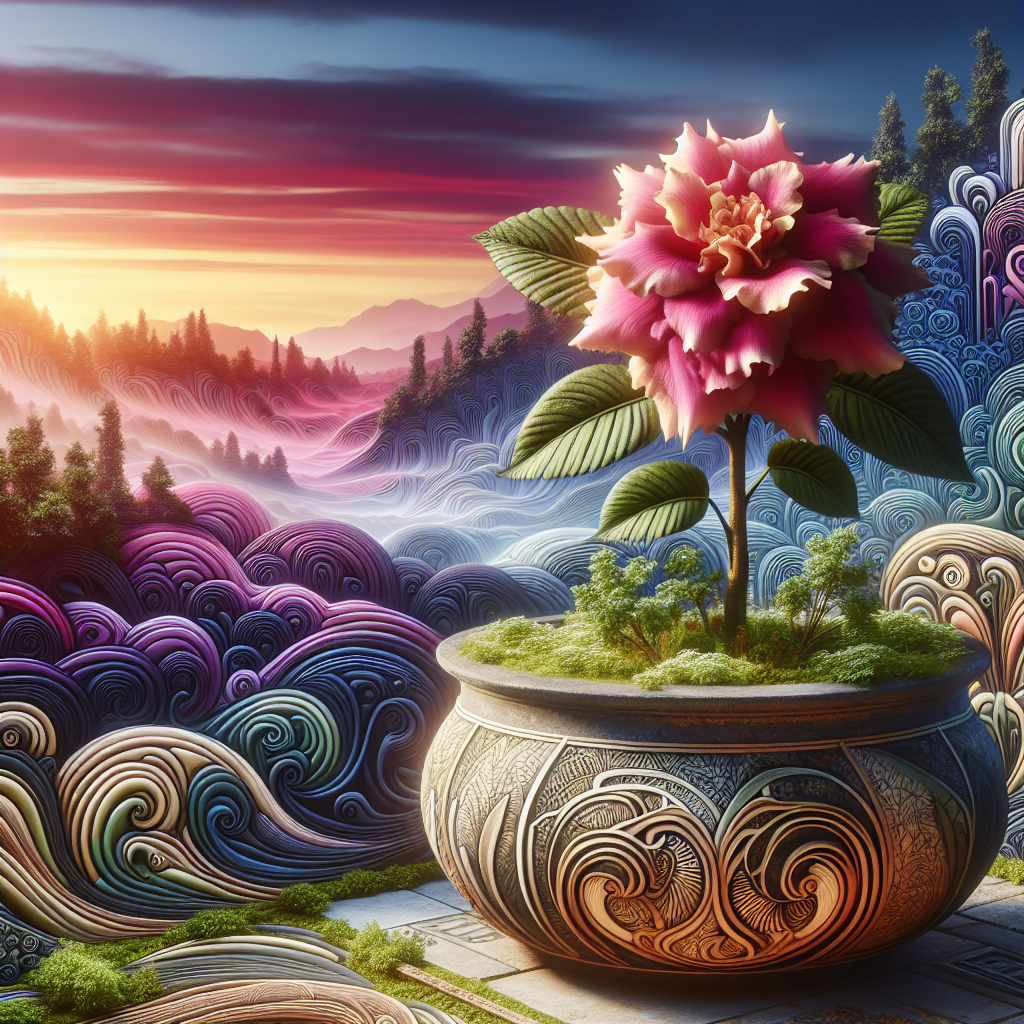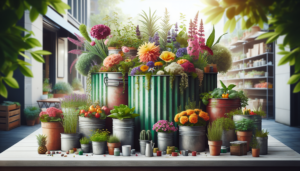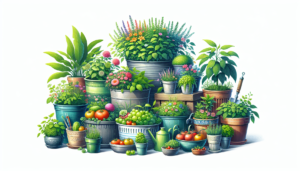
Imagine transforming your outdoor space into a breathtaking oasis with a stunning container garden landscape. With a variety of colorful flowers, ornamental grasses, and carefully selected plants, you can create a visually striking arrangement that will enhance the curb appeal of your home. Whether you have a small balcony or a spacious backyard, the possibilities are endless when it comes to designing a container garden that reflects your personal style and brings a touch of nature to your surroundings. From selecting the perfect containers to choosing the right soil and plant combinations, this article will guide you on how to create a beautiful and captivating container garden landscape that will leave your neighbors in awe.
Choosing the Right Containers
Consider Size and Material
When choosing containers for your container garden landscape, it’s important to consider the size and material of the containers. The size of the container should be appropriate for the plants you plan to grow. Larger and deeper containers are better for plants with extensive root systems, while smaller containers work well for smaller plants or for grouping multiple plants together.
The material of the containers also plays a role in the overall look and feel of your container garden. Traditional terracotta pots add a natural and rustic charm, while ceramic or metal containers can add a modern and elegant touch. Plastic containers are lightweight and easy to move around, making them a practical choice for those who like to rearrange their container garden frequently.
Evaluate Drainage Options
Proper drainage is essential for the health and longevity of your plants. Overwatering can lead to root rot and other diseases, so it’s important to consider the drainage options for your containers. Look for containers with drainage holes in the bottom to allow excess water to escape. If your chosen containers don’t have drainage holes, you can drill some yourself or use a layer of gravel at the bottom to improve drainage.
Selecting the Ideal Plants
Determine Sunlight Requirements
Different plants have varying sunlight requirements, so it’s crucial to choose plants that are suitable for the amount of sunlight your container garden receives. Some plants, like succulents, thrive in full sun, while others prefer partial or even full shade. Take note of the sunlight patterns in your garden and select plants accordingly to ensure they receive the amount of light they need to thrive.
Consider Height and Growth Habit
When selecting plants for your container garden, consider their height and growth habit. Tall plants can provide a dramatic focal point and serve as a backdrop for smaller plants, while trailing or cascading plants can add a touch of elegance and soften the edges of your containers. It’s important to choose plants that will not outgrow the containers and overshadow other plants or become overcrowded.
Choose Plants with Complementary Colors
To create a visually stunning container garden, choose plants with complementary colors. Consider the color scheme of your outdoor space and select plants that will add pops of color or blend harmoniously with the surrounding environment. Mixing plants with different flower colors, foliage colors, and textures can add depth and visual interest to your container garden landscape.
Consider Seasonal Interest
When choosing plants for your container garden, consider their seasonal interest. Select plants that will provide blooms or interesting foliage throughout the seasons to ensure your container garden looks beautiful all year round. You can choose a combination of annuals, perennials, and evergreens to create a dynamic and ever-changing container garden landscape.
Designing the Layout
Group Plants Based on Watering Needs
To make caring for your container garden easier, group plants with similar watering needs together. This allows you to water them efficiently and prevents overwatering or underwatering certain plants. For example, grouping plants that require frequent watering in one container and drought-tolerant plants in another container ensures that each plant receives the appropriate amount of water.
Consider Different Textures and Foliage Colors
Another important aspect of designing your container garden is considering the different textures and foliage colors of the plants. By combining plants with different leaf shapes, sizes, and textures, you can create an interesting and visually appealing container garden landscape. Mix plants with broad leaves, fine leaves, and plants with variegated foliage to add depth and contrast to your containers.
Create Focal Points
Incorporating focal points is a great way to add a sense of visual interest and create a captivating container garden landscape. Choose one or two standout plants or unique containers to act as focal points in your design. These focal points can be placed strategically to draw attention and create a sense of balance and harmony in your container garden.
Preparing the Containers
Clean and Disinfect the Containers
Before planting, it’s important to clean and disinfect your containers to remove any dirt, debris, or potential pathogens. Use a mild detergent and warm water to scrub the containers, rinse them thoroughly, and allow them to air dry. Disinfecting the containers can be done by soaking them in a solution of 1 part bleach to 10 parts water for about 10 minutes, and then rinsing them again.
Add Drainage Material
For containers without drainage holes, adding drainage material at the bottom can help improve water drainage. Use a layer of gravel, small stones, or broken pottery pieces to create a space between the soil and the container’s bottom. This allows excess water to collect at the bottom without saturating the roots of the plants.
Fill with Quality Potting Mix
To provide your plants with the nutrients they need to thrive, fill your containers with quality potting mix. Avoid using garden soil, as it can become compacted and drain poorly in containers. Look for potting mixes specifically designed for container gardening, which are lightweight, well-draining, and enriched with organic matter.
Planting Techniques
Start with Taller Plants at the Center or Back
When planting your container garden, start with taller plants at the center or back of the container. This creates a sense of height and provides a focal point for the design. Taller plants can add vertical interest and serve as a backdrop for smaller plants or trailing varieties.
Place Medium-Height Plants Around the Center
After placing the taller plants, surround them with medium-height plants. This helps to create a visually interesting composition and fills in the middle portion of the container. Choose plants with complementary colors or contrasting foliage to add depth and texture to the arrangement.
Intersperse Low-Growing Plants at the Edges
To soften the edges of your containers and add a finishing touch, intersperse low-growing plants at the edges. These plants can cascade over the sides of the container or create a border around the taller and medium-height plants. Select trailing or spreading plants that will spill over the edges and create an enchanting and lush look.
Give Each Plant Enough Space
When planting your container garden, it’s important to give each plant enough space to grow and thrive. Crowding plants together can restrict their root growth and lead to competition for nutrients and water. Follow the spacing recommendations for each plant and ensure they have enough room to spread out and reach their full potential.
Caring for Your Container Garden
Provide Adequate Watering
Proper watering is crucial for the health and vitality of your container garden. The watering needs of plants can vary, so it’s important to monitor the moisture levels and adjust your watering routine accordingly. Generally, containers should be watered when the top inch of the soil feels dry to the touch. Water the plants thoroughly, ensuring that the water reaches the roots, but avoid overwatering, as it can lead to root rot.
Fertilize Regularly
Container plants rely on the nutrients provided by the potting mix, which can deplete over time. To keep your plants healthy and flourishing, it’s important to fertilize regularly. Choose a slow-release fertilizer specifically formulated for container plants and follow the instructions for application. Additionally, you can supplement with liquid fertilizers during the growing season to provide an extra boost of nutrients.
Monitor for Pests and Diseases
Just like any other garden, container gardens are susceptible to pests and diseases. Regularly inspect your plants for signs of pests such as aphids, mealybugs, or spider mites. If an infestation is detected, take appropriate measures to control and eradicate the pests, whether it be through natural remedies or organic pest control products. Similarly, keep an eye out for any signs of diseases such as powdery mildew or root rot and take prompt action to prevent the spread.
Prune and Deadhead as Needed
To keep your container garden looking neat and tidy, it’s important to prune and deadhead your plants as needed. Remove any dead or dying leaves, flowers, or stems to encourage new growth and maintain the overall health of the plants. Regular pruning can also help shape your plants and prevent them from becoming too leggy or overcrowded.
Seasonal Maintenance
Replace Annuals with Seasonal Plants
As the seasons change, consider replacing annual plants with seasonal plants to keep your container garden looking fresh and vibrant. Annual plants have a limited lifespan and will eventually stop flowering or die back. By replacing them with new seasonal plants, you can ensure that your container garden remains colorful and visually appealing throughout the year.
Protect Containers in Winter
During the winter months, it’s important to protect your containers from freezing temperatures and harsh weather conditions. Move containers to a sheltered location, such as a garage or covered porch, or wrap them with insulating material to prevent the soil from freezing and damaging the roots of your plants. Mulching the top of the soil with straw or leaves can also provide additional protection.
Refresh and Rearrange as Desired
Container gardening offers flexibility and versatility, allowing you to refresh and rearrange your garden as desired. Take advantage of this by periodically refreshing the plants in your containers or rearranging them to create a new look. Experiment with different color combinations, plant arrangements, or even swap out containers for a different style or size.
Creative Container Ideas
Repurpose Household Items as Containers
Get creative with your container choices by repurposing household items as planters. Old buckets, teapots, wooden crates, or even discarded furniture can make unique and charming containers for your plants. When repurposing items, ensure they have proper drainage and make any necessary modifications to accommodate the plants.
Use Hanging Baskets for Vertical Interest
Hanging baskets are a great way to add vertical interest to your container garden landscape. Hang them from porch ceilings, pergolas, or tree branches to create stunning visual displays. Choose trailing or cascading plants that will spill over the edges of the baskets and create a beautiful curtain of foliage and flowers.
Create a Herb or Edible Garden
Take your container gardening to the next level by creating a herb or edible garden. Grow your own fresh herbs, vegetables, or fruits in containers, making it convenient to access while adding a functional and sustainable element to your outdoor space. Choose compact varieties or dwarf fruit trees that are suitable for container gardening.
Experiment with Succulents or Cacti
For a low-maintenance and drought-tolerant container garden, consider experimenting with succulents or cacti. These plants come in a wide variety of shapes, sizes, and colors, making them a versatile choice for container gardening. Succulents and cacti are well-suited to dry and arid climates and require minimal watering and maintenance.
Complementary Features
Add Decorative Elements
Enhance the visual appeal of your container garden by adding decorative elements. Incorporate decorative stones, garden ornaments, or sculptures that complement the style and theme of your outdoor space. These elements can add character and personality to your container garden while creating a cohesive and aesthetically pleasing landscape.
Incorporate Lighting
Extend the enjoyment of your container garden into the evening hours by incorporating lighting features. Place solar-powered or LED lights strategically around your containers to highlight the plants and create a cozy and inviting atmosphere. Lighting can add a magical touch to your container garden landscape and allow you to enjoy it even after the sun sets.
Include Water Features or Bird Baths
Adding water features or bird baths to your container garden can attract wildlife and create a tranquil oasis. Choose a small fountain, a bird bath, or even a miniature pond to create a focal point and provide a water source for birds, butterflies, and other beneficial creatures. The sound of trickling water can also add a relaxing element to your outdoor space.
Common Mistakes to Avoid
Neglecting Drainage
One of the most common mistakes in container gardening is neglecting proper drainage. Without adequate drainage, excess water can accumulate and lead to root rot or other water-related issues. Always choose containers with drainage holes or modify them to ensure proper drainage. Additionally, avoid overwatering your plants and monitor the moisture levels regularly.
Overcrowding Containers
Another mistake to avoid is overcrowding your containers. It can be tempting to plant more plants than the container can handle, but overcrowding leads to competition for resources and restricts the growth and development of your plants. Follow the spacing recommendations for each plant and give them enough room to thrive.
Using the Wrong Soil
Using the wrong soil can greatly affect the health and growth of your container plants. Avoid using garden soil, as it tends to be heavy and can become compacted in containers. Instead, choose a high-quality potting mix specifically designed for container gardening. These mixes are lightweight, well-draining, and enriched with nutrients to support healthy plant growth.
Not Adapting to Changing Seasons
Each season brings different environmental conditions, and it’s important to adapt your container garden to these changes. Some plants may thrive in warmer temperatures, while others may prefer cooler conditions. Pay attention to the changing seasons and select plants that are appropriate for the current climate to ensure their success and longevity.
Ignoring Plant Compatibility
When designing your container garden, it’s important to consider the compatibility of the plants you choose. Some plants have different water, light, or temperature requirements, and pairing incompatible plants together can result in poor growth or even plant death. Research the needs of your plants beforehand and choose plants that will thrive when planted together.
By following these guidelines and tips, you can create a stunning container garden landscape that will be a beautiful and vibrant addition to your outdoor space. Whether you have a small balcony or a spacious patio, container gardening allows you to unleash your creativity and create a personalized oasis that reflects your style and personality. Happy planting!







